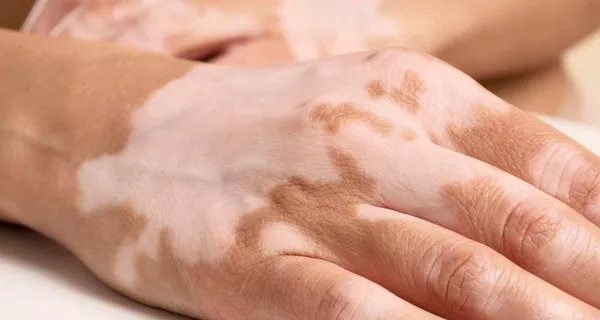Vitiligo is a skin condition characterized by the loss of pigment in certain areas of the skin, resulting in white patches. This condition can be emotionally distressing for those affected, leading many to wonder if there is a definitive cure. In this article, we’ll explore the current understanding of vitiligo, available treatment options, ongoing research, and whether a permanent cure may be on the horizon.
Understanding Vitiligo
Vitiligo occurs when melanocytes, the cells responsible for producing skin pigment (melanin), are destroyed or stop functioning properly. This disruption leads to the development of depigmented patches on the skin. The exact cause of vitiligo remains unclear, but it is believed to involve a combination of genetic, autoimmune, and environmental factors.
The condition affects people of all skin types and can appear at any age, although onset often occurs before the age of 20. Vitiligo patches can vary in size and location, and their progression is unpredictable. While vitiligo itself is not harmful or contagious, its psychological impact can be significant, affecting self-esteem and quality of life.
Current Treatment Options
While there is no universally accepted permanent cure for vitiligo, several treatment options can help manage the condition and promote repigmentation. These treatments aim to restore pigment to the affected areas and may include:
1. Topical Medications: Corticosteroid creams or ointments can be applied to the affected skin to help reduce inflammation and promote repigmentation.
2. Phototherapy: This involves exposing the skin to ultraviolet (UV) light, either through narrowband UVB therapy or psoralen combined with UVA (PUVA) therapy. Phototherapy can stimulate pigment production in the skin.
3. Surgical Procedures: In cases where other treatments are ineffective, surgical methods such as skin grafting, micropigmentation (tattooing), or depigmentation of the remaining skin may be considered.
4. Oral Medications: Oral corticosteroids or immunomodulating drugs may be prescribed to suppress the immune system’s attack on melanocytes.
The effectiveness of these treatments can vary depending on factors such as the extent of vitiligo, the patient’s age, and the location of the affected areas. Some individuals experience significant repigmentation, while others may see limited results.
Challenges in Finding a Permanent Cure
Finding a permanent cure for vitiligo remains challenging due to the complex nature of the condition. Researchers continue to investigate potential underlying causes and pathways involved in melanocyte destruction. Key challenges in developing a definitive cure include:
1. Autoimmune Component: Vitiligo is often associated with autoimmune mechanisms, where the body’s immune system mistakenly targets and destroys melanocytes. Understanding and controlling these immune responses without compromising overall immune function is a complex task.
2. Genetic Factors: Genetic predisposition plays a role in vitiligo, with certain gene variations increasing susceptibility to the condition. Identifying specific genetic markers and their interactions could pave the way for targeted therapies.
3. Heterogeneity of Vitiligo: Vitiligo presents differently among individuals, making it difficult to develop a one-size-fits-all treatment approach. Factors such as age of onset, rate of progression, and response to treatment vary widely.
Promising Research and Emerging Therapies
Despite these challenges, ongoing research offers hope for more effective treatments and, potentially, a permanent cure for vitiligo. Some promising areas of investigation include:
1. Stem Cell Therapy: Researchers are exploring the use of melanocyte transplantation derived from stem cells to repopulate depigmented areas. Early studies have shown promising results in restoring pigment to the skin.
2. Immunomodulatory Drugs: Novel drugs targeting specific immune pathways involved in vitiligo are being developed to suppress autoimmune responses while minimizing side effects.
3. Gene Therapy: Advancements in gene editing technologies offer the potential to correct genetic mutations associated with vitiligo, potentially preventing melanocyte destruction.
4. Biologics: Biological therapies that target specific molecules involved in immune dysregulation are being investigated as potential treatments for vitiligo.
While these emerging therapies show promise, further research is needed to establish their safety, efficacy, and long-term outcomes in treating vitiligo.
The Outlook for Individuals with Vitiligo
For individuals living with vitiligo, ongoing dermatological care and support are essential. Dermatologists can help tailor treatment plans to address specific needs and monitor progress over time. Additionally, support groups and counseling services can provide emotional support and resources for managing the psychosocial impact of the condition.
While a definitive cure for vitiligo may not yet be available, advances in research and treatment options offer hope for improved outcomes and quality of life for individuals affected by this condition. Continued investment in research and collaboration among clinicians, researchers, and patients will be critical in advancing towards a future where vitiligo is effectively managed or cured.
Conclusion
In conclusion, while a permanent cure for vitiligo remains elusive, ongoing research and advancements in treatment offer hope for the future. By addressing the underlying mechanisms of the condition and developing targeted therapies, researchers aim to provide effective solutions that restore skin pigmentation and improve the lives of those affected by vitiligo. Until then, comprehensive care and support remain essential for managing the physical and emotional aspects of this complex condition.
Related Topics:
























